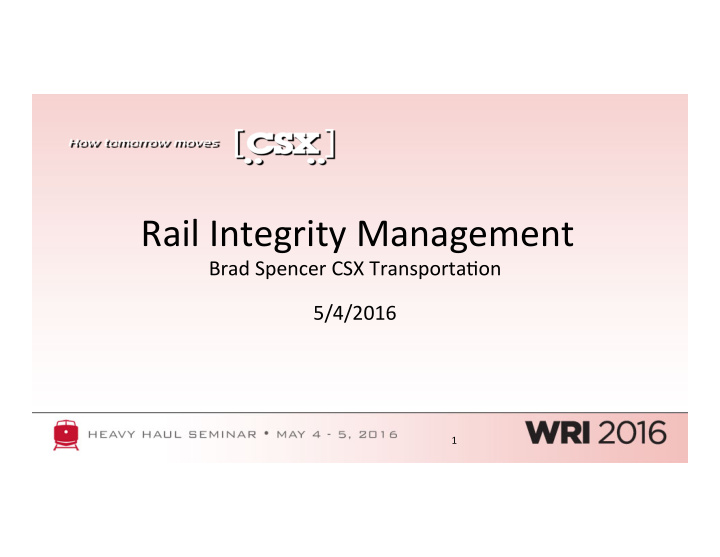



Rail Integrity Management Brad Spencer CSX Transporta9on 5/4/2016 1
Railroad performance Long Term Trend • Reduced broken rail derailments – CSX’s Total FRA Reportable Broken Rail Main and Siding Derailments 35 This includes T201, T202, T203, T204, T207, T208, T210, 30 T211, T212, T219, T220, T221 25 20 15 10 5 0 2000 2001 2002 2003 2004 2005 2006 2007 2008 2009 2010 2011 2012 2013 2014 2015 Total 27 24 23 32 17 23 22 23 16 14 14 7 8 7 9 2 2
Risk Evalua9on FRA 213 • FRA regula9on and CSX evaluates segments of track based on Service Failures per mile per year. • FRA regula9ons were published in 2014. – .10 RSF per year per mile of track for class 4, or class 5 – .09 RSF per year per mile of track with passenger or Hazmat for class 3, class 4, and class 5. – .08 RSF per year per mile of track with Hazmat and passenger for class 3, class 4, and class 5. 3
Correc9ve Ac9ons • Adjust Rail Test Frequency • Rail Grinding • Capital Planning – Rail Replacement • Lubrica9on / Fric9on Modifiers • Temporary Slow Order and Remedia9on • Develop and explore new technologies and advancements in Service Failure Preven9on 4
Rail Test Integra9on and Modeling Rail Defect Inputs into the model, Data Detected Defect Data • Service Failure Defect Data • Previous Frequencies • Risk Rail Tes9ng Track informa\on – SGL, 1, 2,.. • Assignment HazMat Routes • Tonnage • Passenger Routes • Speed • Signal informa9on Rail Test Test • Frequencies Scheduling 5
Rail Replacement – Extending and maximizing life is accomplished by many factors and not just one. CSX uses a holis9c approach. – Taking all the inputs and pu\ng your resources where you need it based on many factors. • Defect history • Age of rail • Wear and predic9ve wear • Risk assignment • Curvature and Grade 6
Collect Data Inspec9on, Repair, VTI, Rail Defects, Geometry, Requests Integrate Data Inputs Track Condi9on Analysis and Forecas9ng Analyze Track Charts, System Analysis, Integrated track inspec9on, Track Work Planning and requests, Capital and OE Planning , … 7
Rail Grinding Maintenance or Correc9ve Grinds • Rail is the most expensive component of the track • Grinding has evolved to help control wear on rail and wheel by managing • WR Contact. Frequencies are based on many variables • – Including type of track – Tonnage – curvature – Profile 8
Lubrica9on/ Fric9on Modifiers – Gage Face • Lubrica9on in curves has proven to be an effec9ve technique to reduce rail and wheel wear • Extends wear life • Reduces curving forces • Reduces Wheel Flanging noises 9
Lubrica9on/ Fric9on Modifiers – Top Of Rail Fric9on Modifiers • CSX has been using TOR now for over 5 years • Wheel tread to distribute the fric9on modifier • Reduces wheel flanging noise and wheel squeal • Posi9ve fric9on during wheel slippage • Reduces L/V Forces which reduces rail rollover and gage widening • Reduces Rail corruga9on 10
What is new and coming to help manage rail integrity Eddy Current • Laser based ultrasonic • Phased Array • Big Data Integra9on • Run on Run Real Time Analysis of Test Data • Base Rail Tes9ng • Con9nuous Non- Stop Ultrasonic Tes9ng • ….. • Advancements in Machine Vision for RCF • Thermal Imaging • *** All will be a piece of the puzzle for lowering risk 11
Recommend
More recommend